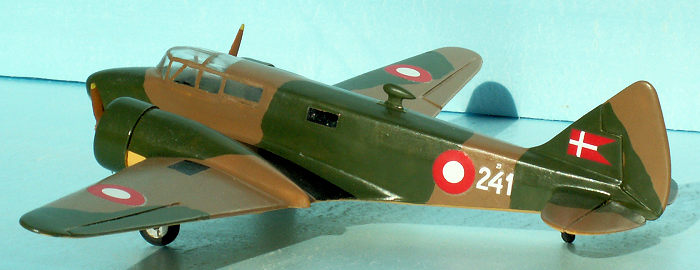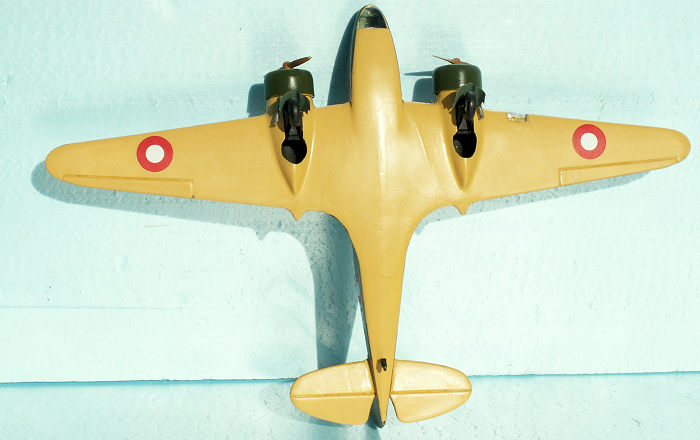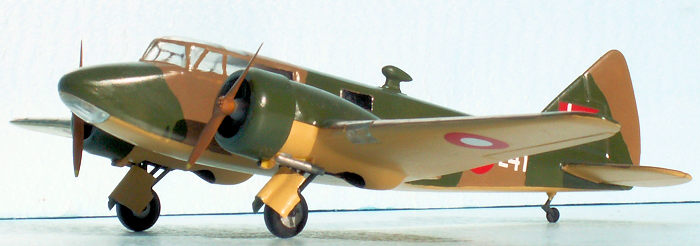
Frog 1/72 Airspeed Oxford II
| KIT #: | F-336 |
| PRICE: | 4 shillings in 1968 |
| DECALS: | one option |
| REVIEWER: | Torben Plesberg |
| NOTES: | Classic kit, model Royal Danish AF 1952 |

| HISTORY |
The Oxford was developed in the 1930s as a trainer aircraft to prepare pilots for the new generation of bomber aircraft. The Airspeed AS 6 Envoy commercial passenger aircraft was the forerunner of the Oxford, and the two aircraft have an obvious resemblance. The prototype of the Oxford made its maiden flight in the middle of 1937, and Airspeed obtained immediately orders for mass production. At that time, a major conflict with Germany was anticipated, and the RAF was ordered to expand its strength considerably.
 As the
war came, several thousands of Oxfords were ordered by Britain and its allies,
including the United States. In fact, so many aircraft were ordered, that
Airspeed was unable to deliver all of them. De Havilland at Hatfield, Percival
Aircraft at Luton and Standard Motors at Coventry produced together more than
3.500 Oxfords. The grand total of Oxfords produced was 8751, quite an impressive
number.
As the
war came, several thousands of Oxfords were ordered by Britain and its allies,
including the United States. In fact, so many aircraft were ordered, that
Airspeed was unable to deliver all of them. De Havilland at Hatfield, Percival
Aircraft at Luton and Standard Motors at Coventry produced together more than
3.500 Oxfords. The grand total of Oxfords produced was 8751, quite an impressive
number.
The Oxfords fulfilled several important tasks. Mostly as a trainer aircraft for bomber crews, which the Oxford was especially suitable to, because it was difficult to fly. The Oxford also served as an ambulance plane and as a maritime patrol aircraft. The normal crew was three: a pilot, a co-pilot (student) and a wireless operator in the cabin.
The aircraft was powered by two Armstrong Siddeley Cheetahradial IX or X engines each developing 355 hp or 375 hp. It had a top speed of 300 km/h, and an endurance of 5½ hours. Some versions were armed with a 7.7 mm Vickers machine gun in a dorsal turret and could carry sixteen 5 kilogram practice bombs externally.
The Ox-box was capable of training a complete aircrew for Bomber Command at the same time: pilot, navigator, bomb aimer, gunner and wireless operator. No wonder, so many Oxfords were produced!
T he
aircraft was an immense success during WWII. After the war, many surplus Oxfords
were sold to foreign air forces. In 1946, 44 Oxfords were sold to the air forces
of the Danish Army, and the aircraft were four years later taken over by the
Royal Danish AF, which was established in 1950. The aircraft were flown with the
British color scheme and even with the British serials. After a year, however,
they got Danish serials: 201 – 253. Some of the serials were for some reason not
used: 205 – 210. The British color scheme remained unchanged throughout the
service time.
he
aircraft was an immense success during WWII. After the war, many surplus Oxfords
were sold to foreign air forces. In 1946, 44 Oxfords were sold to the air forces
of the Danish Army, and the aircraft were four years later taken over by the
Royal Danish AF, which was established in 1950. The aircraft were flown with the
British color scheme and even with the British serials. After a year, however,
they got Danish serials: 201 – 253. Some of the serials were for some reason not
used: 205 – 210. The British color scheme remained unchanged throughout the
service time.
The Danish Oxfords were used as trainers, liaison planes, transport and as target tugs. After a few years in service, it turned out that the wooden construction of the Oxfords began rotting, and it was decided to retire the type. Most of the aircraft were scrapped. The aircraft still in good condition were sold on the civil market in Denmark and Sweden. The Danish Company “Transair” purchased five aircraft, four of these crashed during service. Transair used the Oxfords for newspaper deliveries from Kastrup Airport and to a number of larger cities in Denmark. They were also used for mapping photography for the Danish Geodetic Institute. By 1962, only the former 21-241 with the civil registration OY-FAO survived, and the following year it was scrapped. This aircraft is the subject of model, as it appeared in the colors of Flyvevåbnet and with the serial: 21-241. I have several photos of the OY-FAO taken in 1962. A couple of the Oxfords of Transair were in fact civil conversions: AS 65 Consul with a glazed cupola in the nose.
| THE KIT |
The kit comes in a small box with a picture of a RAF Oxford on the lid. The instructions is a single folded sheet.
On one
side, there is assembly instructions and a single large exploded sketch showing
how to put the parts t ogether, how to paint the details and the position of the
transfers, as the decals were called at that time. And some advice, too: Do use
FROG Polystyrene Cement and FROG Paints!
ogether, how to paint the details and the position of the
transfers, as the decals were called at that time. And some advice, too: Do use
FROG Polystyrene Cement and FROG Paints!
On the other side, there is a short history of the Oxford, including the main data, a three view drawing showing the camouflage pattern, and a color key – presumably for FROG Paints! There is a list of other available FROG kits in four different scales. Finally, there are seven “Gold Tokens”, and if you collect enough of these (15, 30 or 45) you can get a free gift: different kinds of balsa gliders!
There are four yellow warped sprues and a sprue with transparent parts. However, the yellow styrene parts are not at all warped, and they fit very well together! It is an old kit - I would without hesitation call it a quality kit for its days. There is a decal sheet with one option: RAF Oxford ED170 “C9” belonging to no 22 Maintenance Unit in May 1942.
| CONSTRUCTION |
Building the FROG Oxford implies no great problems. Most of the parts fit well together, with the exception of cowlings and nacelles. The top of the cylinders must be sanded round to conform with the inner gauge of the cowlings. The nacelles of the assembled wings must also be trimmed to make the cowlings fit upon the circular openings.
The
transparent parts also fit well, however the bomb aimer’s glazing in the nose
need some trimming to fit properly to the rounding in the front of the fuselage.
The Oxfords had two different types of main wheel doors: only the two door
system is with the kit. The other system comprises a single large door covering
the  undercarriage leg and the upper half of the wheel, and must be
scratch-built, if your model requires this. The 241 has the front door system,
and I cut and bended the doors from the very thin aluminum cover of a tea-light.
The problem was actually how to fasten these doors. A tiny piece of plastic
strip (1.5 x 1 mm) was glued to the crossing stringers of the gear leg, and the
door was glued to this “base” with super glue. My doors may be a little too
large. My only reference was my photos, unfortunately, I did not take them with
the building of a model in mind! However, the photos were far better as a
reference - than nothing.
undercarriage leg and the upper half of the wheel, and must be
scratch-built, if your model requires this. The 241 has the front door system,
and I cut and bended the doors from the very thin aluminum cover of a tea-light.
The problem was actually how to fasten these doors. A tiny piece of plastic
strip (1.5 x 1 mm) was glued to the crossing stringers of the gear leg, and the
door was glued to this “base” with super glue. My doors may be a little too
large. My only reference was my photos, unfortunately, I did not take them with
the building of a model in mind! However, the photos were far better as a
reference - than nothing.
The transparency covering the landing lights was difficult to sand for a proper fit. Two 3 mm gauge discs were punched from a piece of self adhesive metal foil, and I placed them in the recess as the landing lights. The cockpit is very simple: only a floor with a seat for the pilot. It would be a waste of time to detail the cockpit further, as nothing can be seen, when the canopy is in place. The canopy had two large scratches, one on each inner side. Fortunately, it was possible almost to eliminate them with a sanding stick, and polish with a grain 8000 stick to regain transparency.
| COLORS & MARKINGS |
 The
Danish Oxfords kept the British camouflage colors the entire service life with
Flyvevåbnet. Undersides are trainer yellow, HB 24, and upper sides a camouflage
pattern of dark earth, HB 29 and dark earth, HB 30. Engines and exhausts are gun
metal, HB 53, propellers wood with yellow tips, undercarriage black, black tires
with aluminum hubs. Wheel wells and inner sides of wheel doors are interior
Green, HB 78.
The
Danish Oxfords kept the British camouflage colors the entire service life with
Flyvevåbnet. Undersides are trainer yellow, HB 24, and upper sides a camouflage
pattern of dark earth, HB 29 and dark earth, HB 30. Engines and exhausts are gun
metal, HB 53, propellers wood with yellow tips, undercarriage black, black tires
with aluminum hubs. Wheel wells and inner sides of wheel doors are interior
Green, HB 78.
The decals are from a Stoppel Decals sheet covering all Danish Oxfords. The Danish national insignia in red and white: four roundels on the wings, two smaller on the fuselage and split flags on the fin. The serial number of the aircraft is 241 in large white numbers, and a small 21 above for the aircraft type. Even the black walkways were with the sheet. The decals are of good quality and easy to apply.
| CONCLUSIONS |
The ancient FROG Oxford kit was released in 1963. It is a nice and precise kit and produces a fine little model of a classic aircraft of the WWII period. The kit is recommendable for all modelers who fancy trainer and transport aircraft, and of course for WWII aircraft fans, too.
| REFERENCES |
Wikipedia article: Airspeed Oxford.
Two articles from the Danish Air Magazine “FLYV” and IPMS quarterly “IPMS-nyt”.
My own photos of OY-FAO, ex Flyvevåbnet 21-241, taken at Kastrup Airport in 1962.
27 January 2020 Copyright ModelingMadness.com If you would like your product reviewed fairly and
fairly quickly, please
contact
the editor or see other details in the
Note to
Contributors.